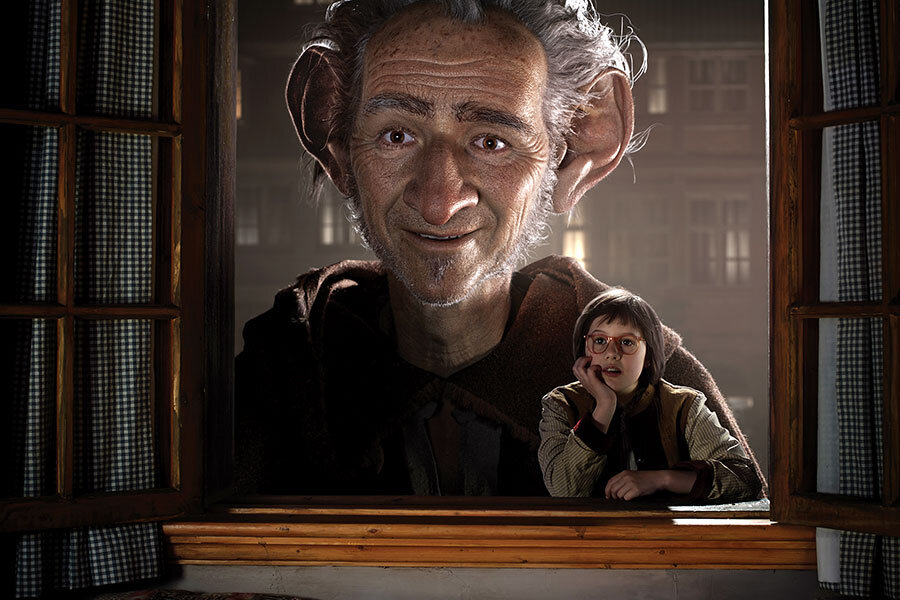'The BFG' never sustains liftoff
Loading...
Steven Spielberg’s “The BFG,” adapted by the late Melissa Mathison from the 1982 Roald Dahl novel, harks back, thematically if not favorably, to “E.T.” It’s about Sophie (Ruby Barnhill), a spunky, bespectacled 8-year-old orphan from central London who is plucked from her forbidding orphanage in the middle of the night by a 26-foot giant with a spindly neck, sharp nose, and floppy ears, played by a special effects-enhanced Mark Rylance. (From some angles, he resembles a sky-high Sean Penn.) Sophie had the misfortune of opening the curtains and spotting the skulking giant through her window, and so, fearing she will reveal his existence to humans, he whisks her to his secret underground cave in a remote area inhabited by giants far less fond than he.
The giant, you see, is, as Sophie soon dubs him, a BFG – big, friendly giant. After a suitable interval in which she pleads to return to the orphanage, it becomes clear she is happier with the BFG, who at least cares for her and doesn’t dole out punishments. Unlike the other giants nearby, who have names like Meatdripper and Fleshlumpeater, the BFG is not a carnivore. But the Neanderthal-looking yowlers who populate the barren terrain sense fresh meat and so Sophie, with the flustery BFG’s aid, must periodically hide away on a moment’s notice.
The BFG, whose diction is a mash-up of quasi-nonsensical English that at times recalls Lewis Carroll’s locutions – fizzy water, for example, is “frobscottle” – occupies his time collecting and storing dreams in glowing bottles in the recesses of his cave. These dreams are mostly blissful, but they can be frightening, too, and it is Sophie’s brainstorm to combat the bad giants by instilling them with bad dreams, with the assist, as it turns out, of no less than the Queen of England (Penelope Wilton) and her military minions. (The time is the 1980s.)
Dreamworks is the name of the studio Spielberg cofounded, and clearly he sees himself as a kind of dreamcatcher. When his movies are really soaring, as in “E.T.” and “Close Encounters of the Third Kind,” that’s exactly what he is. For such a phenomenally savvy director, he still seeks to retain a core of childlike wonder, a sense of mission: Movies are our ribbon of dreams and he wants us to dream our way to a better place.
Try as he might, though, Spielberg never sustains liftoff in “The BFG.” This material is probably too typecast for him now; the childlike wonder seems processsed. With his extraordinary facility, he can turn out a film like “The BFG” and, at least superficially, it seems like a classic. But true kidcentric classics – like “E.T.” or Carroll Ballard’s “The Black Stallion,” which was also written by Mathison – are not as doggedly one-note as this film. “Classic” should not be mistaken for monotonous, and it was always Spielberg’s great gift to infuse his fantasias with fun. “The BFG” is best not when we are held captive with Sophie and the BFG as he intones his ditties and speaks of “the secret whisperings of the world.” It’s best when Sophie, in her finest schoolmarmish mode, chides the BFG for ingesting a fizzy bottle of frobscottle and letting loose a whizzpopper.
Obviously Spielberg does not see it the way I do. The comic scenes in “The BFG,” which also include some very funny goings-on in Buckingham Palace, are adroitly handled. (The BFG, accidentally smashing an antique chandelier with his head, introduces himself to the bemused Queen as “your humbug servant.”) But clearly his heart is with the dreamcatcher stuff. And for that to work, it would have been better if a child with a more poetic force field than first-timer Barnhill had been cast. Barnhill does nothing conspicuously wrong, but she’s too dutiful a performer. In some ways, she seems more artificially concocted than Rylance’s CGI BFG.
Rylance gives a rueful rendition of the friendly giant. We can see how dashed he is by the sorrows of the world. The solitariness of his life is not easily dispelled, not even by Sophie at her most Mary Poppins-ish. I think that Rylance’s brooding performance represents the ways in which Spielberg was hoping to deepen this fable. (In Dahl’s book, the BFG is far more antic.)
If there is not enough fun in “The BFG,” it’s telling that there is also not enough fear. The cannibal giants are galumphing grotesques who are never shown (unlike in Dahl) eating any human “beans.” The obverse of childhood wonderment is childhood cold sweats, and Spielberg, not wishing to roil the dreamweaver scenario, keeps the upsets to a minimum. He doesn’t want to “cheapen” the bliss. The result is that the wonderment, with nothing serious at risk, seems lackluster. There is more going on behind the curtain than this sweet but insubstantial fable allows for. Grade: B- (Rated PG for action/peril, some scary moments and brief rude humor.)







